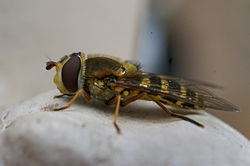| Parasyrphus annulatus | |
|---|---|
 | |
| male | |
 | |
| female | |
| Scientific classification | |
| Kingdom: | Animalia |
| Phylum: | Arthropoda |
| Class: | Insecta |
| Order: | Diptera |
| Family: | Syrphidae |
| Genus: | Parasyrphus |
| Species: | P. annulatus |
| Binomial name | |
| Parasyrphus annulatus (Zetterstedt, 1838) | |
| Synonyms | |
| |
Parasyrphus annulatus is a Palearctic species of hoverfly. [1]